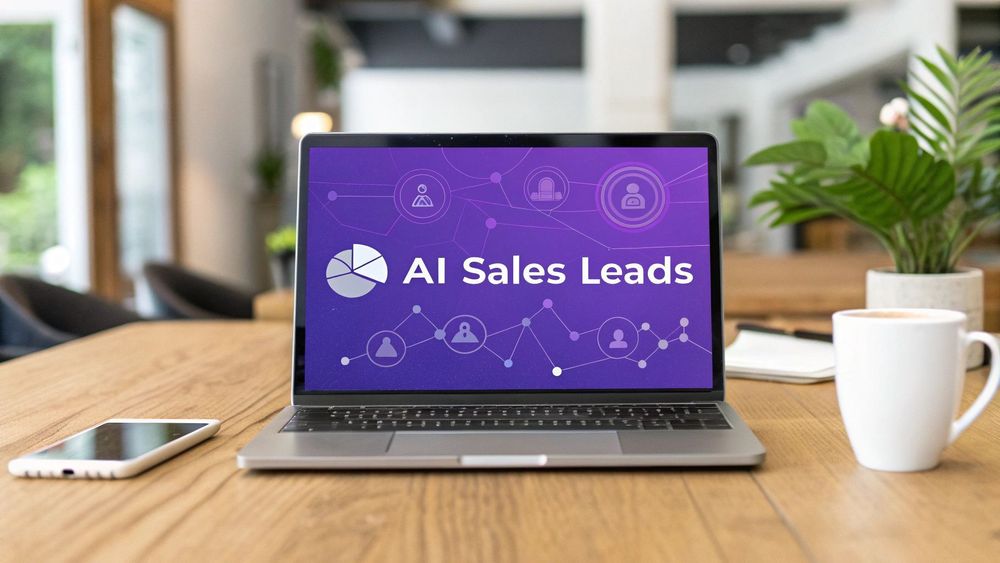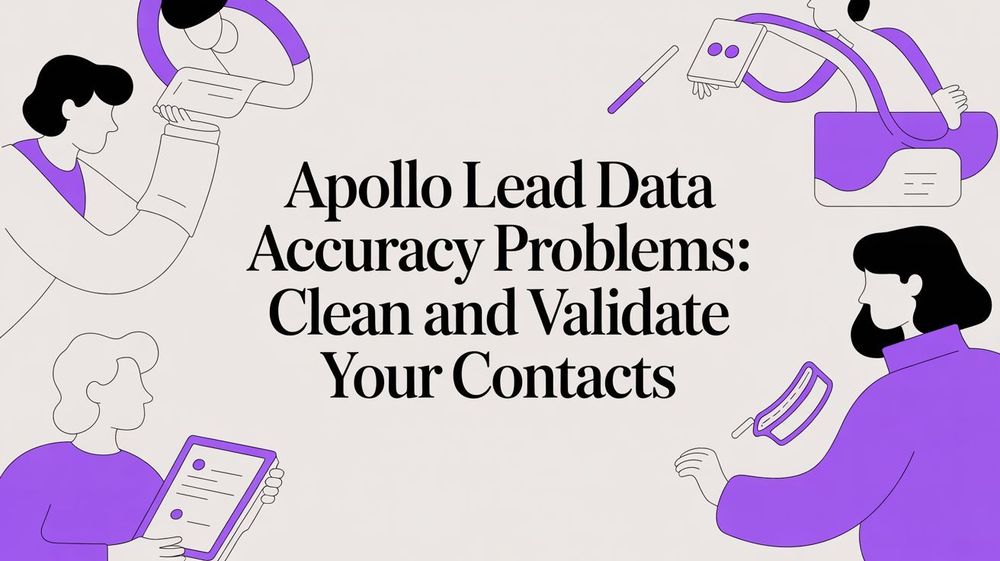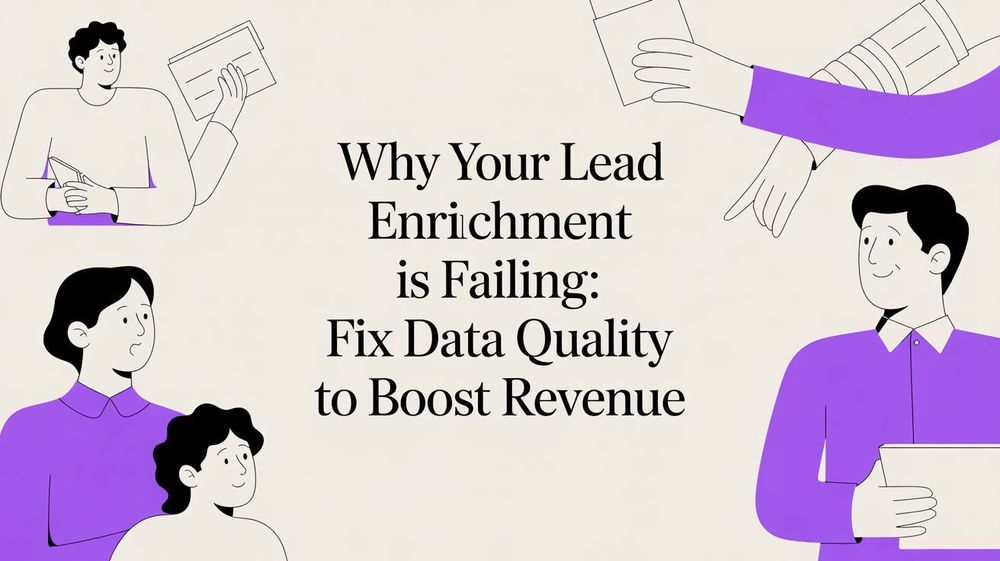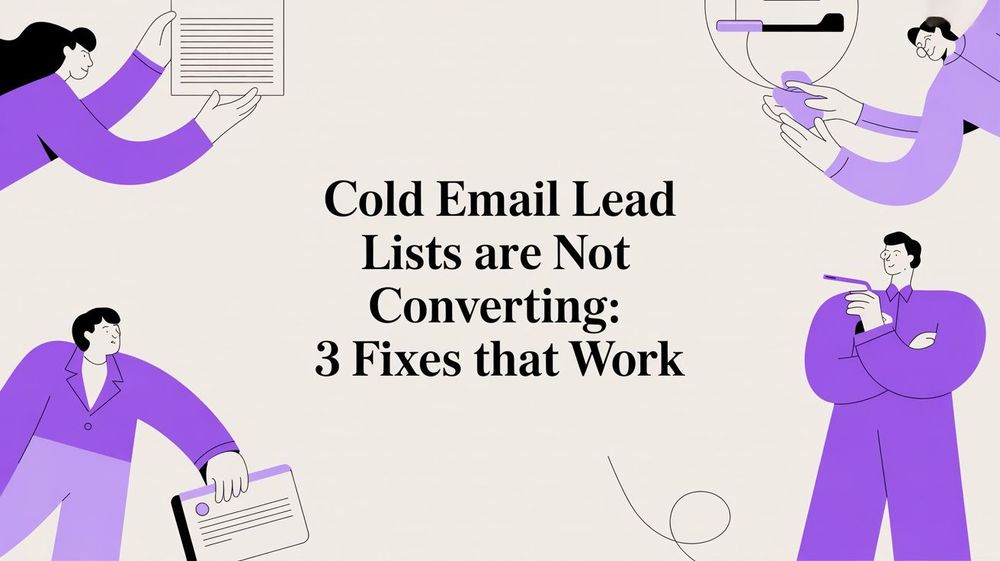Using an AI scraper tool boils down to a simple, powerful workflow: identify where your ideal customers are online, use a one-click tool like ProfileSpider to extract their profile data in seconds, and then export those organized lead lists directly to your CRM. This modern approach transforms lead generation from a manual chore into a strategic advantage, saving hours of tedious work.
From Manual Prospecting to AI-Powered Growth
Remember the traditional way of finding sales leads? It was a time-consuming grind. You'd spend hours manually searching websites, copying and pasting contact information into spreadsheets, and wrestling with outdated, inaccurate data. This manual process is not just slow—it's inefficient and prone to errors.
That manual approach is a recipe for wasted hours and missed opportunities. Sales teams stuck in this cycle spend more time on data entry than they do on what truly matters: selling.
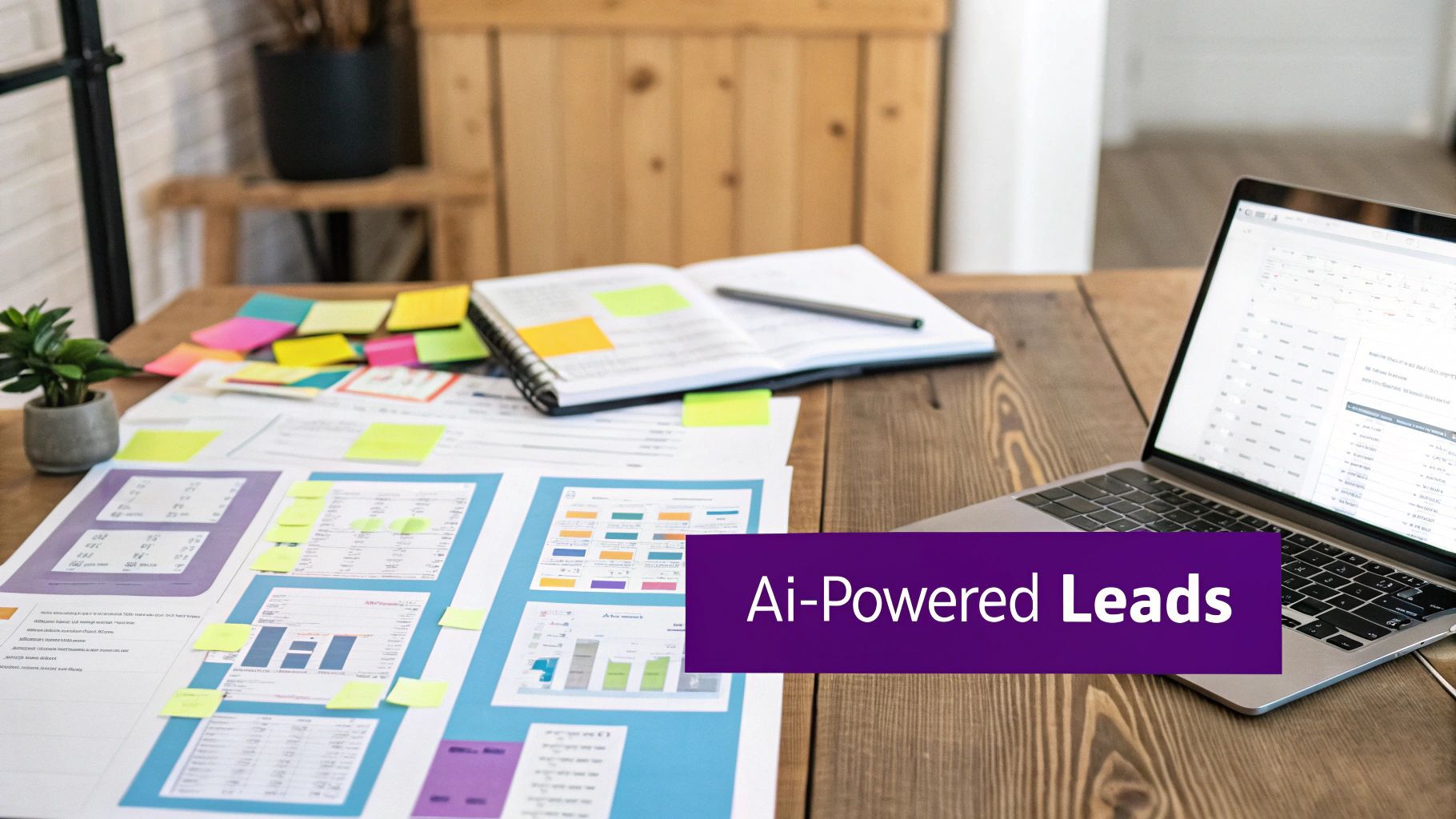
AI scraper tools fundamentally change the game. Lead generation becomes a strategic, data-driven operation. Instead of hours of painstaking research, the process is compressed into a few simple clicks.
The Problem with Traditional Lead Generation
The old-school method of prospecting is filled with productivity-killing problems that directly impact your bottom line. Sales professionals get bogged down in low-value tasks that prevent them from closing deals.
Here are the common challenges:
- Time-Consuming Data Entry: Manually typing names, job titles, and company details from websites into a spreadsheet is brutally inefficient. It pulls you away from building relationships with potential customers.
- Inaccurate and Outdated Information: Data decay is a constant issue. A lead list built last quarter is likely full of outdated contacts today, leading to bounced emails and wasted outreach efforts.
- Inability to Scale: There's a hard limit to how many profiles one person can manually research in a day. This bottleneck stunts your pipeline growth and makes it impossible to scale outreach campaigns effectively.
The real issue with manual prospecting isn't a lack of effort—it's a broken process. AI scrapers don't replace salespeople; they give them superpowers by eliminating the low-value administrative work that kills productivity and morale.
This isn't just about convenience. Companies that adopt AI scraping tools report a 50% increase in sales-ready leads and have cut their customer acquisition costs by as much as 60%. The data on AI lead generation speaks for itself.
The Modern AI-Powered Solution
Let's compare the two approaches to see the stark difference.
Manual Prospecting vs AI Scraping: A Quick Comparison
| Metric | Traditional Manual Method | AI Scraper Tool (like ProfileSpider) |
|---|---|---|
| Time Investment | 10-15 hours per week | Minutes per day |
| Data Accuracy | Low; prone to human error and data decay | High; real-time extraction from the source |
| Scalability | Limited by individual capacity | Virtually unlimited |
| Cost-Effectiveness | High labor costs, low ROI | Low subscription cost, high ROI |
| Lead Quality | Often inconsistent and unqualified | Highly targeted and structured |
| Workflow | Cumbersome, multi-step process | Simple, one-click extraction |
The table makes it clear: the modern approach is a complete overhaul of the lead generation process.
AI scrapers like ProfileSpider provide a no-code, one-click solution designed for sales professionals, recruiters, and marketers—not developers. They automate the entire data extraction process, delivering accurate, structured information in seconds.
To learn more about how this technology can transform your entire sales pipeline, explore this complete guide to automated lead generation. It shows you how to build a scalable system that turns prospecting from a necessary evil into a strategic advantage.
Step 1: Find Your Ideal Prospects on Any Website
Your best sales leads aren't just on LinkedIn. While it's a great starting point, high-intent prospects often gather in niche corners of the web—places your competitors might overlook.
For example, imagine a sales rep targeting marketing managers in the SaaS industry. Where are they really spending their time online?
- Industry Forums and Communities: Discussing marketing automation challenges in specialized forums.
- Professional Directories: Listed as certified professionals in a specific marketing discipline.
- Conference Speaker and Attendee Lists: Featured on speaker pages for upcoming industry events.
- Company 'About Us' Pages: Listed on the team pages of fast-growing startups you want to target.
These sources are goldmines, but manually extracting that data has always been the challenge. This is where universal website compatibility changes the game for sales teams.
Beyond LinkedIn: The Power of Universal Scraping
Traditional scraping tools were often built for a single site, like LinkedIn, and would break with any layout change. To scrape a different website, you needed a developer to write a custom script—a slow and expensive process.
Modern AI scraper tools have overcome these limitations. A tool like ProfileSpider uses a smart extraction engine that automatically understands and adapts to different website structures. It analyzes a page’s code, recognizes patterns indicating a professional profile, and extracts key data points without any setup or configuration.
This means any public webpage with professional profiles becomes a potential source of high-quality leads. You're no longer limited to a single platform, dramatically expanding your prospecting universe.
The interface is designed for non-technical users, allowing you to extract profiles from virtually any website with a single click.
This screenshot shows how the AI automatically detects and organizes profiles from a webpage into a clean, structured format, ready for management and export.
A Real-World Prospecting Scenario
Let's return to our sales rep targeting SaaS marketing managers. Instead of relying solely on LinkedIn, they can now build a smarter, more targeted list of websites to scrape.
- Target Niche Blogs: They identify the top 10 blogs covering SaaS marketing and scrape contributor pages or comment sections to find engaged professionals.
- Find Industry Awards: They find a website listing the "Top 50 SaaS Marketers of the Year" and extract the entire list in one click.
- Check Conference Agendas: An upcoming virtual summit has its full speaker list online. They scrape the page to get a pre-vetted list of industry leaders.
By looking beyond the obvious platforms, you tap into pools of leads who are actively demonstrating their interest and expertise. This context makes your outreach feel significantly warmer and more relevant.
Each of these sources provides more than just a name and title; they offer valuable context for personalizing your outreach. That’s the real advantage of a versatile AI scraper tool—it turns the entire public web into your personal lead database. You can learn more about how to use an AI scraper to uncover these hidden opportunities and build a stronger sales pipeline.
The key is to think creatively about where your ideal customers congregate online and then let the technology handle the heavy lifting of data collection.
Step 2: Extract and Qualify Leads with a Single Click
If you've ever built a lead list manually, you know the tedious routine. You find a great source—like a conference speaker page or a company directory—and the grind begins. Click a profile, copy a name, switch to a spreadsheet, paste. Back and forth, over and over. For a page with just 50 profiles, this can take hours of mind-numbing data entry.
This is where modern AI scraper tools completely change the workflow.
Instead of that manual slog, the process becomes incredibly simple. With a tool like ProfileSpider, you navigate to your target page and click a button. The AI scans the page, identifies every profile, and extracts all relevant data in seconds.
The Power of One-Click AI Extraction
What once took an afternoon is now done in moments. This is the core of what makes these tools so effective for generating sales leads. The technology is designed to recognize and capture structured data without any manual effort.
It intelligently distinguishes between different pieces of information, extracting:
- Personal Details: Full Name, Job Title, Current Company
- Contact Info: Publicly available emails and phone numbers
- Location Data: City, State, Country
- Digital Footprint: URLs for LinkedIn, Twitter, and other social profiles
This infographic highlights high-value lead sources that are perfect targets for this kind of one-click extraction.
As you can see, your best leads are often found in these niche online locations, making the speed of AI extraction a massive advantage.
Instantly Qualify As You Go
Extracting data is only half the battle. You also need to qualify those leads. An AI scraper delivers structured information that makes qualification easy. You can immediately see if a prospect's job title or company aligns with your Ideal Customer Profile (ICP).
Here’s a breakdown of the typical data points an AI scraper can automatically extract.
Data Points Extracted by AI Scrapers
| Data Category | Specific Fields Extracted | Business Value |
|---|---|---|
| Identity & Role | Full Name, Job Title, Company Name | Instantly verify if the person matches your ICP based on their role and industry. |
| Contact Info | Email Addresses, Phone Numbers (Public) | Provides direct lines for outreach without manual searching. |
| Location | City, State, Country | Helps you segment leads by territory and tailor your messaging to local contexts. |
| Online Presence | LinkedIn Profile URL, Twitter Handle | Offers pathways for social selling and deeper research into a lead's professional background. |
This structured data enables your sales team to stop guessing and start prioritizing the most promising prospects right away.
Many advanced tools use Natural Language Processing (NLP) to analyze unstructured text like profile summaries, making the qualification process even more precise.
Furthermore, some tools offer powerful enrichment features. If a scraped profile is missing an email, a tool like ProfileSpider allows you to click “Enrich”. It will then automatically visit that person's social profiles to find and add the missing contact details.
This collapses the old, slow process of "extract, then research" into a single, unified action. You get a clean, qualified, and enriched lead list ready for outreach in a fraction of the time.
The numbers back this up: sales teams using AI for scraping and enrichment reduce the time spent on manual data entry and qualification by up to 40%. You get the critical data needed to focus on high-value prospects from the start.
Step 3: Organize and Manage Your Lead Pipeline
Extracting a large list of leads is a great start, but it's just the beginning. The real value comes from turning that raw data into conversations and deals. Many sales teams struggle here, drowning in messy spreadsheets that are difficult to track and segment.
Effective pipeline management is what transforms a simple list of names into a high-performance sales engine. Without a solid system, leads go cold, you send duplicate emails, and you lose track of your progress. The goal is to move from a chaotic data dump to a clean, actionable workflow.
This is where the smart organization and management features built into modern AI scrapers shine. Instead of exporting everything into one massive CSV file, you can start organizing prospects the moment you capture them.
From Chaos to Clarity with Custom Lists
Imagine a sales manager preparing for the next quarter. They've just scraped a list of 500 potential leads from various industry websites. In the past, this would all be dumped into one spreadsheet, creating an immediate organizational headache.
With a tool like ProfileSpider, that manager can create unlimited custom lists on the fly, directly within the tool. This allows for intelligent segmentation based on their sales strategy from the very beginning.
- By Territory: Create lists like "North America Q3," "EMEA Q3," and "APAC Q3," and assign them to the appropriate sales reps.
- By Product Line: Segment leads into buckets like "Enterprise Software Prospects" or "SMB SaaS Leads" to align with specialized sales teams.
- By Campaign: Group leads for a specific outreach initiative, such as a "Webinar Follow-up" or a "Competitor Switch Campaign."
This simple step—creating lists—transforms a jumble of data into a structured, manageable asset, bringing instant clarity to your sales pipeline.
Adding Context with Tags and Notes
A lead's profile data tells you who they are, but it doesn't tell the full story. To make your outreach effective, you need context. Tags, notes, and statuses act as a lightweight CRM within your lead generation tool.
Let's return to our sales manager. As they review the "North America Q3" list, they can add layers of crucial information:
- Tags: Apply tags like
Hot Lead,Decision-Maker, orFollow-up Q4to quickly filter and prioritize contacts. A sales rep can then instantly pull up all "Hot Leads" in their territory. - Notes: A manager might add a note like, "Met at the SaaS conference in June, interested in our integration features." This provides a perfect, personalized opening for the sales rep's first email.
- Statuses: Track a lead’s journey with statuses such as
New,Contacted,Meeting Scheduled, orNot a Fit, giving you a clear overview of your pipeline's health.
This level of organization ensures no lead falls through the cracks. It turns a static list into a dynamic pipeline where every prospect's status and history is clear, preventing embarrassing duplicate outreach or missed follow-ups.
Keeping Your Data Clean and Private
This integrated approach also improves data hygiene and privacy. ProfileSpider automatically flags and helps you merge duplicate profiles, ensuring your lists remain clean and accurate from the start.
Crucially, it addresses a major business concern: data control. All your extracted profiles, notes, and tags are stored locally in your browser’s IndexedDB. Your data is not sent to external servers without your explicit consent, giving you complete ownership and control. This local-first approach is key for maintaining compliance and protecting your valuable lead data.
Step 4: Integrate Leads and Scale Your Outreach
Collecting and organizing leads is a critical first step, but the ultimate goal is to turn that clean data into conversations. The final, most important step is putting all that work into motion. If you don't have a seamless way to move leads into your sales and marketing tools, even the best data will go unused.
You need a smooth workflow that feeds your sales engine, enabling you to launch personalized, multichannel outreach campaigns that resonate with your audience. This is how you transform a list of names into a thriving sales pipeline.
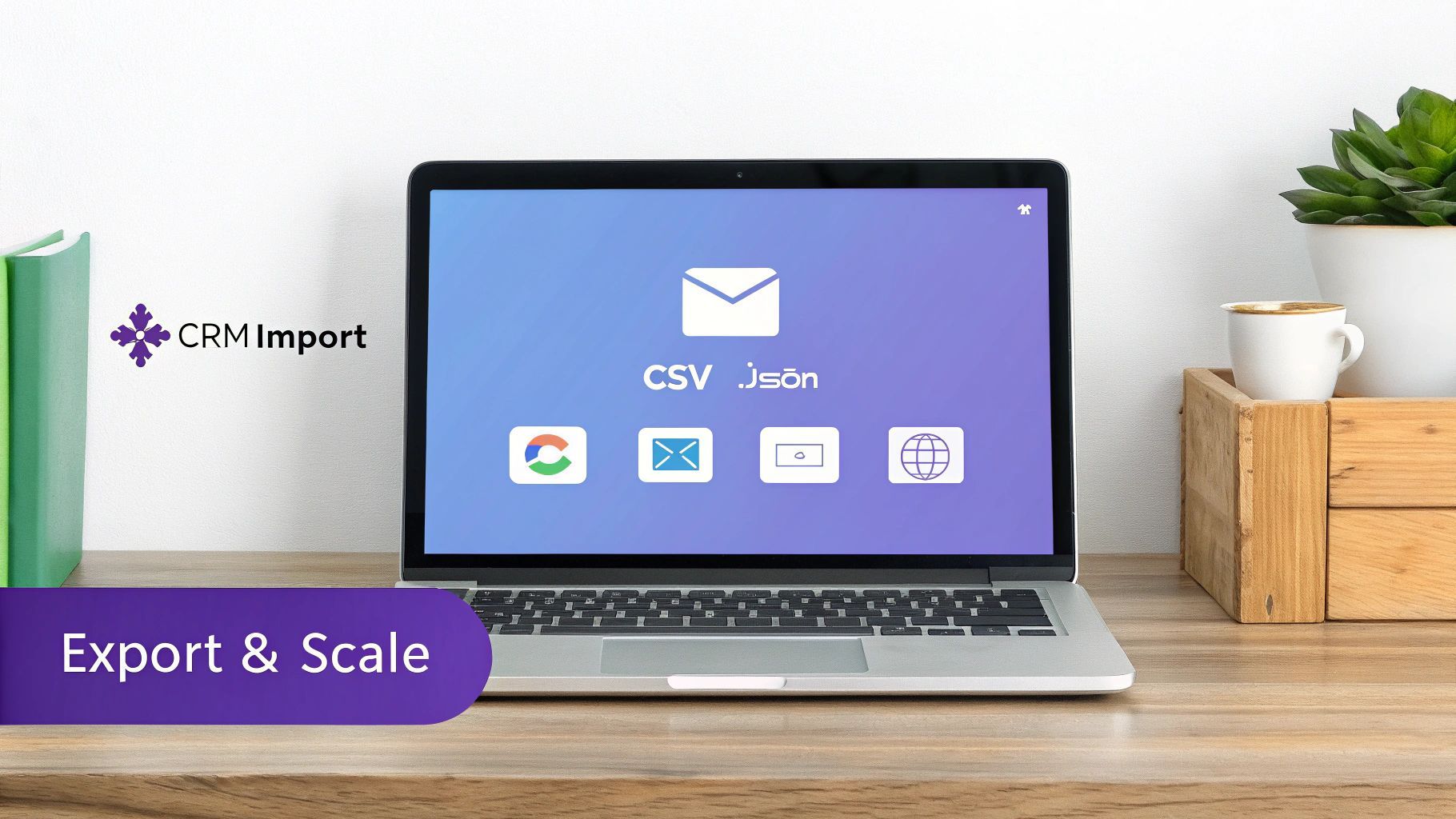
From Scraper to CRM in a Few Clicks
The old way of transferring data was clunky. You’d export a generic spreadsheet and then spend hours reformatting columns, cleaning up entries, and wrestling with your CRM’s import requirements. It was another manual bottleneck that slowed everything down.
Modern AI scrapers like ProfileSpider eliminate this process with professional, flexible export options. You can export your organized lead lists directly into formats that your other tools understand instantly.
- CSV & Excel Exports: These are the standard formats for most sales and marketing platforms, generating clean, structured spreadsheets ready for immediate upload.
- JSON Exports: For teams with more technical needs or those building custom integrations, JSON provides a structured data format perfect for APIs.
The key is customization. Before exporting, you can choose exactly which data fields to include and in what order, perfectly matching the import template of your CRM or outreach platform. No more manual data wrangling.
Key Takeaway: The ability to customize exports connects your prospecting directly to your sales execution. It transforms a painful, error-prone data transfer into a simple, one-click action, saving time and maintaining data integrity.
For a deeper dive into this workflow, read our guide on how to automatically feed your sales pipeline by connecting web scraping with your CRM.
Fueling Personalized Outreach at Scale
The purpose of using AI scraper tools isn't just to collect data—it's to enable smarter, more effective outreach. Accurate, detailed information is the fuel for personalization that cuts through the noise.
When your lead list is enriched with correct job titles, company details, locations, and social profiles, you can move beyond generic templates. Your outreach becomes relevant and contextual.
For instance, you could:
- Reference a lead's specific role and responsibilities in your opening line.
- Mention their company’s recent funding round or a relevant industry trend.
- Connect with them on a professional network with a personalized message that shows you’ve done your research.
This level of detail dramatically increases your chances of getting a response. Companies that combine AI-powered scraping with modern outreach platforms have reported up to a 65% increase in response rates to their initial campaigns. This happens because AI scrapers deliver the contextual signals needed for true personalization at scale.
Ultimately, AI scraping tools provide the high-quality fuel your outreach needs to succeed. By shortening the path from finding a prospect to engaging them personally, you don't just boost reply rates—you accelerate the entire sales cycle, allowing your team to focus on building relationships and closing deals.
Best Practices: Stay Compliant and Respect User Privacy
Using AI scraper tools to generate sales leads comes with significant responsibility. In an era where data privacy is paramount, how you collect and handle information reflects on your company's reputation and legal standing. Cutting corners is not an option.
The core of responsible scraping is respecting user privacy and complying with regulations like GDPR. This requires tools that put you in control of your data. Many platforms upload scraped lists to their own servers, creating a privacy blind spot and leaving you with little oversight.
Your Data Stays Your Data
The modern, privacy-first approach is to use a tool that keeps everything on your local machine. ProfileSpider was designed to store 100% of your extracted profiles and notes in your browser’s IndexedDB. Nothing is sent to an external server unless you choose to export your list.
This local-first design gives you complete ownership and control. It’s your lead list, and you decide what happens to it.
Storing data locally gives you total command over your lead generation process. It’s not just about complying with privacy regulations; it’s about having peace of mind, knowing your valuable prospect data is secure, private, and entirely under your control.
Practical Tips for Ethical Lead Generation
Choosing the right tool is only part of the equation. Your entire process must be ethical to build a sustainable lead pipeline.
- Stick to Public Business Information: Only scrape data that is publicly available, such as information from professional networking sites, company directories, and industry pages.
- Check the Terms of Service: Before scraping any website, review its terms of service and always abide by its rules.
- Maintain Legitimate Interest: The information you gather should be used for relevant, professional business communication, not for spamming.
Navigating the legal details can be complex, but adhering to these fundamentals is non-negotiable. For a deeper dive into this topic, learn more about the legal aspects of website scraping in our guide.
Ethical scraping allows you to generate leads with confidence while protecting the brand and reputation you’ve worked hard to build.
Frequently Asked Questions
As you prepare to use AI-powered scraping, a few common questions often arise. Let’s address them so you can start with confidence.
"I'm not a developer. Are AI scrapers difficult to use?"
Not at all. If you can use a browser extension, you can use a tool like ProfileSpider. Modern scrapers are designed to make data collection accessible to everyone on your team—salespeople, marketers, and recruiters included.
Forget about coding or complex configurations. These tools feature simple, one-click interfaces. You navigate to a website, click a button, and the AI handles the rest. They are built for non-technical users who need results fast.
"Am I limited to scraping only LinkedIn?"
Definitely not. While LinkedIn is a primary source for prospecting, limiting yourself to it is a missed opportunity. The best AI scrapers are designed to be universal.
Your ideal customers are on various platforms. A flexible tool like ProfileSpider works on almost any public website, including:
- Corporate "About Us" and team pages
- Online industry directories
- Conference speaker or attendee lists
- Other social media platforms
The AI is smart enough to adapt to different website layouts, so you are never locked into a single source.
The real advantage: This flexibility turns any webpage where your ideal customers gather into a potential lead source, allowing you to find prospects your competitors are overlooking.
"How accurate is the contact information?"
This is a key advantage of using an AI scraper over purchasing static lead lists, which are often outdated.
AI scrapers provide more accurate data in two ways. First, they extract information directly from the source in real-time, ensuring the data is as fresh as possible.
Second, many tools include a “Contact Enrichment” feature. After ProfileSpider extracts the initial profile data, this function helps find and verify missing details like work emails and phone numbers. This two-step process ensures your data is complete and ready for outreach.
"Is web scraping legal and ethical?"
Scraping publicly available data is generally legal, but your approach matters. Operating responsibly is essential for protecting your company's reputation.
Adhere to these best practices:
- Focus on Public Information: Only collect data that is publicly displayed for business purposes. Do not attempt to bypass logins or access private information.
- Respect Website Rules: Always check a site's Terms of Service before scraping. If they prohibit scraping, find another source.
- Don't Spam: Your goal is to initiate relevant, professional conversations, not to send unsolicited bulk messages.
Using a tool like ProfileSpider that stores all scraped data locally on your machine gives you full control and makes it easier to comply with privacy regulations like GDPR. Always prioritize ethics in your lead generation and outreach efforts.

